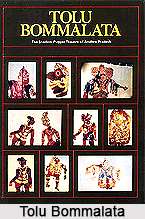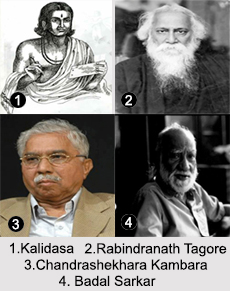 The meaning of Tolu Bommalata is `leather-puppet dance`. This is actually the strongest tradition of shadow theatre in India. Leather puppetry in Andhra Pradesh is famous for its life-size images, highly intricate ornamentation, brilliant colours, rich style of singing, and adoption of Yakshaganam texts to present full-length theatre. The first reference in Telugu literature appears in Palkuriki Somanatha`s Panditaradhya charitramu i.e. `Panditaradhya`s Story`. This indicates the form was highly evolved by that time and called chira marugula bommalata i.e. `puppet dance behind a sari` alluding to its screen. An inscription of 1208 found in Mukkamala village says that Gundapa Nayaka gave a puppeteer some land.
The meaning of Tolu Bommalata is `leather-puppet dance`. This is actually the strongest tradition of shadow theatre in India. Leather puppetry in Andhra Pradesh is famous for its life-size images, highly intricate ornamentation, brilliant colours, rich style of singing, and adoption of Yakshaganam texts to present full-length theatre. The first reference in Telugu literature appears in Palkuriki Somanatha`s Panditaradhya charitramu i.e. `Panditaradhya`s Story`. This indicates the form was highly evolved by that time and called chira marugula bommalata i.e. `puppet dance behind a sari` alluding to its screen. An inscription of 1208 found in Mukkamala village says that Gundapa Nayaka gave a puppeteer some land.
However, the present performers are not of Andhra origin. They are known as Are Marathi or Are Bondili. These families of Maratha or Bundel army background entered the Rayalaseema region of interior Andhra around 1850. They are totally assimilated into Andhra culture and now speak Telugu. Madhavapatnam in East Godavari district is the leading centre with 100 such families, whose ancestors received the art 250 years ago from previous practitioners belonging to the Kamsala community in Andhra. According to them Tolu Bommalata originated in medieval times among the Kamsala goldsmiths and accountants. They persecuted for their Jain faith, and escaped into the forests, where they created a new art of image-making with the medium of leather. Because of their skills at gold crafting, the artisans retained elaborate and intricate ornamentation in every inch of each puppet.
The classic puppets stand from 2 to 3 m tall, and are brightly coloured. They are made originally with vegetable and mineral dyes and later with chemicals. Initially deer skin was used for the characters of divinities and lamb or buffalo skin for the others. The skin is tanned to a transparently thin quality for which the Madiga community is famous. But the technique was picked up by the Marathis. It takes thirty to fifty days to make a life-size puppet. During the festivals of mother goddesses, the skins of sacrificial lambs used to be donated to puppeteers by individuals to make specific characters of their choice in their name as ritual offerings.
After tanning, artisans of three different skills collectively work on each puppet. Image drawing and cutting is the foremost, bringing out the personality. Every figure is cut into several parts such as head, torso, hip, legs, and hands. Each limb is sliced into three at the joints, to facilitate movements. This drawing and cutting is done by the senior craftsmen. The second skill is ornamentation and dressing, by perforating countless tiny holes that let light through to the screen in the shape and design of costumes and jewellery. The third skill is to fill in colours according to traditional patterns. Then all the parts are loosely tied, allowing free movement at each joint. Three stitched bamboo sticks make the puppet workable. As for example one vertical from head to hip, also to hold the figure straight, and the others connected to the forearms.
The manipulation is considered secondary, because everybody in the team from children up knows how to man a puppet. But only the seniors know how to make them. The first-grade puppet-makers of the traditional style are nearly all gone. Since each puppet survives for an average 100-150 years. Because of this longevity very few puppeteers really bothered to learn puppet-making. Practically every child is taught the manipulation and singing in Yakshaganam style. At a show, eight to ten members stand behind a huge white screen about 5 m wide and 2-3 m high to manipulate the figures. The screen is erected very tight, without any folds, but kept slightly slanted from top to bottom, leaning a little to the inside so that slight errors in the fall of the image can be covered. Traditionally, castor-oil torches illuminated the puppets behind the screen to give soft and red light. These days, Petromax pressure lamps or red electrical bulbs are used. Each puppet is held almost touching the screen from behind, keeping the manipulator`s body away. Generally, each puppeteer handles one character at a time, singing and talking suitably while making special sound effects.
The Yakshaganam repertoire is mostly based on the Ramayana and Mahabharata. The best teams are capable of staging these epics in ten parts, each part in ten days, at the rate of three hours daily. In earlier times, with overnight shows, a two-month festival could be possible for each epic. The troupes performed only a few chapters every season at the villagers` request. Apart from the regular puppet seasons i.e. in winter and summer there is a belief that a dedicated performance, particularly Rama natakam brings rain during periods of famine.
Before the show commences, the puppets of the god Ganesh, a Dishtibomma i.e. `evil chaser`, and the comedian Juttupoligadu i.e. `erect-tuft fellow` are displayed. The performance begins with a prayer to Ganesh generally in Raga Todi, followed by the Sabha varnana. This is a song praising the audience and inviting the chief guests. The actual play always starts with Raga Nata and closes with Surati. Mridangam drum, harmonium, and cymbals provide the music. All artistes sing at a very high pitch to reach the thousands of spectators.
The main attraction is three types of comedians who appear in all texts. The first is the husband and wife, Juttupoligadu and Bangarakka i.e. `golden girl`, who always quarrel. Irrespective of the play, the show starts with this couple who also interrupt many times with typical jokes, sometimes connected to the story but mostly on topical issues. The second type of comedian is called Allatappa, whose wit proves superior to the first pair`s. He always provokes the wife against her husband to ignite the quarrel further. The third is known as Ketigadu or `intruder`. This is a tiny puppet, which jumps between everybody and everything even when the screen is full with a dozen characters. Depending on the team`s taste, the comedy turns vulgar sometimes, but tradition has designed this bunch of comedians as the integral part of the show. Since no separate scripts are written for puppetry, the creation of these jesters could be the puppeteers` special genius.
The old generation of Andhras admits that, prior to cinema; Tolu Bommalata surpassed all other kinds of theatre and entertainment in popularity. Now, the last few families of puppeteers cannot survive on this profession alone. Although Tolu puppeteers still operate in the Godavari districts and a few villages in Anantapur, Nellore, Visakhapatnam, and Guntur districts. This great tradition is dying and will soon become extinct.




